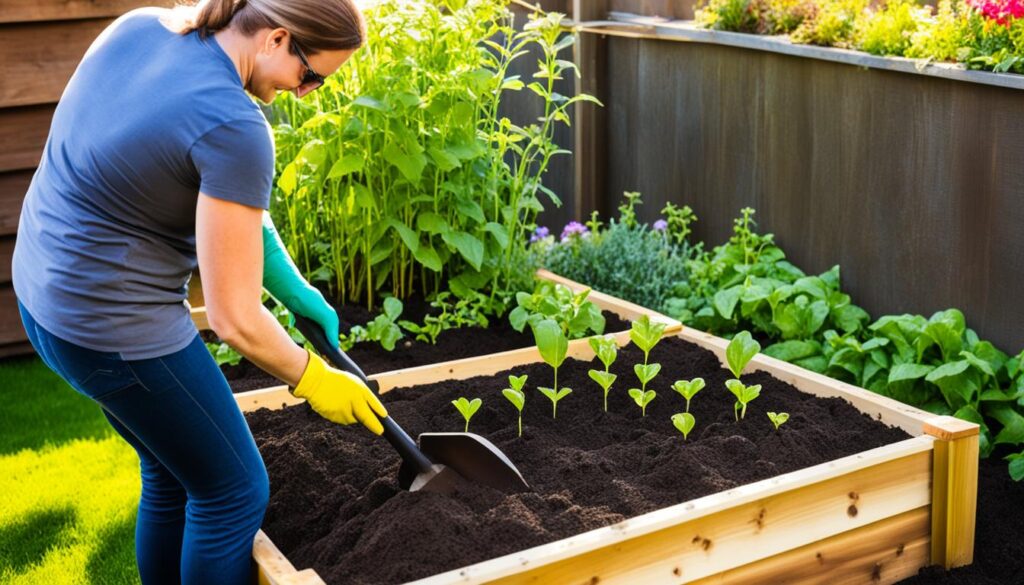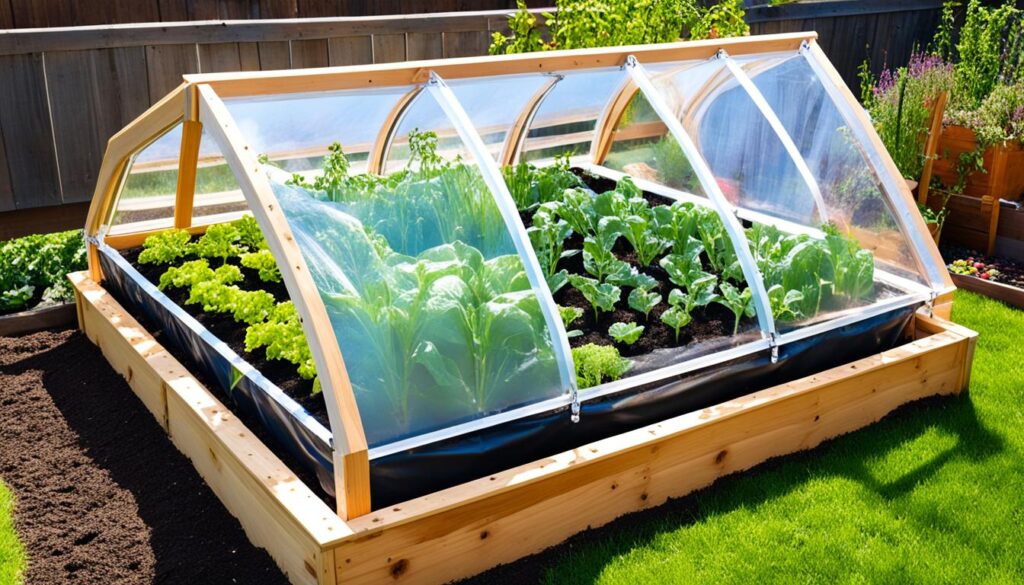Dahlias are beloved for their stunning blooms, but what do you do when your prized dahlias fail to sprout, grow, or bloom as expected? In this article, I will explore the common challenges that gardeners face when it comes to dahlia care and provide valuable tips on troubleshooting dahlia growth, along with essential maintenance practices to ensure your dahlias thrive.
Key Takeaways:
- Insufficient sunlight can hinder dahlia growth and blooming.
- Adequate watering is crucial for promoting healthy dahlia growth.
- Improper fertilization can lead to leaf growth instead of flowers.
- Ensure the soil temperature is suitable for dahlia tuber sprouting.
- Regular deadheading of flowers can prolong the bloom time.
Lack of Sunlight
Dahlias are sun-loving plants that require an ample amount of sunlight to thrive and produce beautiful blooms. Lack of sunlight can impede dahlia growth and result in fewer blossoms. Understanding the sunlight requirements for dahlias is crucial for their successful cultivation.
For optimal dahlia growth, it is recommended to provide them with at least 6 hours of bright sunlight each day. However, in cooler regions, dahlias may require 8 or more hours of direct sun to flourish. On the other hand, in hot regions, it’s best to offer them 6 hours of direct morning sun to protect the flowers from intense afternoon heat.
Proper sunlight exposure ensures that dahlia plants receive the necessary energy to photosynthesize, resulting in vigorous growth and abundant blooms. Lack of sunlight can lead to weak and spindly stems, reduced flower production, and overall stunted growth.
To maximize sunlight exposure for dahlias, consider the positioning of your garden or containers. Choose a location that receives ample sunlight throughout the day, away from tall trees or structures that may cast shadows. It is also important to regularly monitor the sunlight patterns in your garden and make adjustments if necessary, particularly when trees leaf out or when the sun’s angle changes throughout the seasons.
“Dahlias thrive in bright sunlight. Lack of sunlight can hinder growth and result in fewer blooms.”
By ensuring sufficient sunlight for your dahlias, you are providing them with the optimal conditions for healthy growth and abundant flowering. With the right amount of sunlight, you can enjoy the vibrant and stunning blossoms that dahlias are known for.
Sunlight Requirements for Dahlias:
| Sunlight Level | Number of Hours |
|---|---|
| Bright Sunlight | 6 hours per day |
| Cooler Regions | 8+ hours per day |
| Hot Regions | 6 hours of direct morning sun |
Inadequate Watering
Dahlia plants require consistent moisture to support their rapid growth and blooming. Dry soil can impede vigorous growth and result in fewer blooms. It’s important to keep the soil around the dahlia tubers consistently moist after the first leaves emerge. However, overwatering can lead to tuber rot. Deep, thorough watering once or twice a week, combined with a layer of mulch, can help maintain optimal soil moisture for dahlias.
To ensure adequate watering, follow these dahlia water requirements:
- Water deeply and thoroughly once or twice a week.
- Avoid frequent shallow watering, as it may cause inadequate soil moisture.
- Check the soil moisture regularly by inserting your finger into the soil. If it feels dry up to the first joint, it’s time to water.
- Apply mulch around the dahlia plants to help retain moisture and prevent weeds.
Remember to balance watering practices to prevent both inadequate watering and overwatering, as both can negatively impact dahlia growth. By maintaining proper soil moisture, you can help avoid issues such as dahlia tuber rot and ensure healthy and vibrant blooms.
Dahlia Watering Do’s and Don’ts
Do: Water deeply and thoroughly once or twice a week to maintain consistent soil moisture for dahlias.
Don’t: Overwater dahlias, as excessive moisture can lead to tuber rot.

| Watering Mistake | Consequence | Solution |
|---|---|---|
| Inadequate watering | Dry soil, hindered growth, and fewer blooms | Water deeply and thoroughly once or twice a week, ensuring the soil is consistently moist. |
| Overwatering | Tuber rot and potential plant damage | Avoid frequent shallow watering and allow the soil to dry slightly between waterings. |
Improper Fertilization
Dahlias require nutrient-rich soil to fuel their growth and blooming. Fertilizer can supplement the nutrients in the soil, but it’s important to avoid using high nitrogen fertilizers. Excessive nitrogen promotes leaf growth at the expense of flowers. It’s recommended to use a general garden or tomato fertilizer with a balanced N-P-K ratio, such as 5-10-5, to provide the necessary nutrients for healthy dahlia growth.
Proper fertilization is crucial for the optimal growth and blooming of dahlias. While fertilizers can enhance soil fertility, using the wrong type or excessive amounts can have negative effects on your plants. Let me explain why improper fertilization can hinder dahlia growth and how to choose the right dahlia fertilizer.
The Importance of Fertilizing Dahlias
Dahlias are heavy feeders, meaning they require a substantial amount of nutrients to support their robust growth and abundant blooms. While the soil may contain some nutrients naturally, it often lacks the necessary levels to meet the demands of the dahlia plants. Fertilizers help bridge this nutrient gap by supplementing the soil with essential elements required for healthy growth, such as nitrogen (N), phosphorus (P), and potassium (K).
Avoid High Nitrogen Fertilizers
When selecting a dahlia fertilizer, it’s crucial to consider the nitrogen content. Nitrogen is responsible for promoting leaf and stem growth. While this may seem beneficial, an imbalance in nitrogen levels can negatively impact flower production. High nitrogen fertilizers can encourage lush foliage development at the expense of blooms, resulting in a lackluster dahlia display.
Instead, it’s best to opt for a fertilizer with a balanced N-P-K ratio. Look for a product specifically formulated for garden plants or tomatoes, with a ratio such as 5-10-5 or similar. These ratios ensure a sufficient supply of nitrogen for healthy foliage growth, while still providing the necessary phosphorus and potassium for robust root development and vibrant blooms.
It’s important to note that nitrogen requirements may vary depending on the specific soil conditions and dahlia variety. If you’re unsure about the ideal fertilizer ratio for your dahlias, consult a local gardening expert or conduct a soil test to determine the nutrient levels and make adjustments accordingly.
Applying Dahlia Fertilizer
When fertilizing dahlias, it’s crucial to follow the recommended application instructions on the fertilizer packaging. Typically, you’ll need to scatter the fertilizer evenly around the base of the dahlia plants, avoiding direct contact with the stems or foliage. After applying the fertilizer, gently incorporate it into the soil and water thoroughly to help the nutrients penetrate the root zone.
| Fertilizer Type | Nitrogen (N) | Phosphorus (P) | Potassium (K) |
|---|---|---|---|
| Garden Fertilizer (5-10-5) | 5% | 10% | 5% |
| Tomato Fertilizer (5-10-10) | 5% | 10% | 10% |
Note: The table above showcases the nutrient composition of common garden and tomato fertilizers with recommended N-P-K ratios for healthy dahlia growth.
Remember, fertilization is just one aspect of dahlia care. It’s essential to provide proper sunlight, adequate watering, and monitor for any signs of pests or diseases. By taking a holistic approach to caring for your dahlias, you can ensure their optimal growth and enjoy their stunning blooms throughout the season.
Insufficient Soil Temperature
Dahlia tubers require warm soil to start growing and producing flowers. For successful dahlia growth, it is crucial to ensure that the soil temperature is adequate. Planting dahlias too early in cool soil can have negative consequences, such as tuber rot and delayed growth. Therefore, it is important to consider the soil temperature before planting dahlias.
Generally, dahlia tubers need a soil temperature of at least 50°F before they begin to sprout. To determine the suitable time for planting dahlias, it can be helpful to follow the same timeline as for planting tomatoes. This ensures that the soil has reached a favourable temperature for optimal dahlia growth.
Planting dahlias in soil with insufficient temperature can lead to poor sprouting and slow growth. It may also increase the risk of tuber rot, which can be detrimental to the health of the plants.
To ensure that the soil temperature is appropriate for planting dahlias, you can use a soil thermometer. Insert the thermometer into the soil at a depth of 6 inches to get an accurate reading. If the temperature is below 50°F, it is advisable to wait until it has warmed up before planting your dahlias.
By being mindful of the soil temperature and planting dahlias at the right time, you can provide the optimal conditions for their growth and blooming.

Key Points:
- Dahlia tubers require warm soil to start growing and producing flowers.
- They typically need a soil temperature of at least 50°F before they begin to sprout.
- Planting dahlias too early in cool soil can lead to tuber rot and delayed growth.
- It is recommended to plant dahlias around the same time as tomatoes.
- Ensure that the soil has reached a suitable temperature for optimal growth.
Failure to Deadhead Flowers
One common mistake gardeners make when growing dahlias is the failure to deadhead flowers. Deadheading is the process of removing faded or spent flowers, which stimulates the plant to produce more blooms and prolongs the dahlia’s bloom time. Regular deadheading not only enhances the aesthetic appeal of the plant but also encourages more dahlia flowers to emerge until the first frost.
By removing the faded flowers, you redirect the plant’s energy away from seed production and towards the development of new buds. This promotes continuous blooming and ensures that the dahlia plant produces as many vibrant flowers as possible.
Harvesting dahlia bouquets is another way to encourage more flower production. As you cut blooms for arrangements, the plant responds by producing additional buds, resulting in a continual supply of beautiful dahlia flowers in subsequent weeks.
Benefits of Regular Deadheading:
- Extends the bloom time of dahlias
- Stimulates the plant to produce more flowers
- Improves the overall appearance of the dahlia plant
- Encourages continuous blooming until the first frost
To effectively deadhead dahlias, use a pair of clean, sharp pruners or shears. Cut the faded flower just above the first set of leaves or the nearest healthy bud. Be careful not to damage any new growth or emerging flower buds.

Regular deadheading is a simple yet powerful technique to ensure your dahlias flourish and provide a stunning display of vibrant flowers throughout the growing season.
Common Growing Mistakes
Growing dahlias can be a rewarding experience, but it’s essential to avoid common mistakes that can hinder their growth and blooming. By recognizing and rectifying these errors, you can ensure your dahlias thrive and produce abundant blooms. Let’s explore the most common growing mistakes that gardeners make when caring for dahlias:
Insufficient Sunlight
Dahlias require ample sunlight to grow and bloom. Insufficient sun exposure can lead to stunted growth and limited flower production. Make sure to plant your dahlias in a location that receives at least six hours of direct sunlight per day, preferably with morning sun to prevent scorching in hot regions.
Improper Watering
Watering plays a crucial role in dahlia care. Overwatering or underwatering can both cause issues with growth and flowering. Make sure to water your dahlias deeply and regularly, keeping the soil consistently moist. However, avoid waterlogged conditions that can lead to tuber rot.
Improper Fertilization
Choosing the right fertilizer and applying it correctly is vital for healthy dahlia growth. Using high nitrogen fertilizers can result in excessive leaf growth at the expense of flowers. Opt for a balanced fertilizer with a lower nitrogen content to promote optimal blooming.
Planting Too Early
Planting dahlias before the soil temperature has warmed up sufficiently can hinder their growth. Wait until the soil temperature reaches at least 50°F to avoid rotting tubers and delayed sprouting. Plant your dahlias at the same time as tomatoes for optimal results.
Failure to Deadhead Flowers
Deadheading is the practice of removing faded blooms to encourage continuous flower production. Neglecting to deadhead dahlias can result in fewer blooms and shorter blooming periods. Regularly remove spent flowers to prolong the flowering season and stimulate the production of new blooms.
“Avoiding common growing mistakes and providing proper care will ensure successful dahlia growth and blooming.”
To summarize, by providing sufficient sunlight, proper watering, balanced fertilization, timely planting, and regular deadheading, you can avoid common growing mistakes and maximize the growth and blooming potential of your dahlias.
| Common Growing Mistakes | Impact on Dahlia Growth |
|---|---|
| Insufficient sunlight | Stunted growth, limited flower production |
| Improper watering | Issues with growth and blooming, tuber rot |
| Improper fertilization | Excessive leaf growth, fewer flowers |
| Planting too early | Tuber rot, delayed sprouting |
| Failure to deadhead flowers | Fewer blooms, shorter blooming periods |
By avoiding these common growing mistakes and providing proper care, you can ensure successful dahlia growth and enjoy the beauty of abundant blooms.
Troubleshooting Dahlia Growth Problems
If you’re experiencing issues with your dahlia plants not coming up or blooming, it’s essential to troubleshoot the problem. By identifying and addressing the specific issues, you can promote healthy dahlia growth and successful blooming. Here are some common troubleshooting steps to help you get your dahlias back on track:
1. Check Sunlight Exposure
Ensure that your dahlia plants are receiving adequate sunlight. Dahlias need at least 6 hours of bright sunlight each day to produce flowers. Lack of sunlight can hinder dahlia growth and result in fewer blooms. If your dahlias are not getting enough sun, consider moving them to a sunnier location or trimming nearby plants that may be casting shade.
2. Adjust Watering Practices
Inadequate watering can also be a culprit behind stunted dahlia growth. Make sure you are providing consistent moisture to your plants, as dry soil can impede their growth. Deep, thorough watering once or twice a week, combined with a layer of mulch, can help maintain optimal soil moisture for dahlias. However, be cautious not to overwater as it can lead to tuber rot.
3. Ensure Proper Fertilization
Dahlias require nutrient-rich soil to fuel their growth and blooming. Improper fertilization can hinder their progress. Avoid using high nitrogen fertilizers, as excessive nitrogen promotes leaf growth at the expense of flowers. Instead, use a balanced fertilizer with a ratio such as 5-10-5 to provide the necessary nutrients for healthy dahlia growth.
4. Evaluate Soil Temperature
Insufficient soil temperature can delay dahlia growth. Ensure that the soil has reached a suitable temperature of at least 50°F before planting your dahlias. Planting them too early in cool soil can lead to tuber rot and hinder their growth. Wait until the soil has warmed up to promote optimal growth.
5. Address Diseases and Pests
Diseases and pests can also affect dahlia growth. Keep an eye out for common problems such as fungal diseases, aphids, or slugs. If you notice any signs of infestation or disease, take appropriate measures to address the issue promptly. This may involve using organic remedies or seeking professional guidance.
By following these troubleshooting steps and addressing any problems that may arise, you can overcome dahlia growth issues and enjoy healthy, blooming plants in your garden.
Precautions for Dahlia Success
To ensure the success of dahlia growth and blooming, there are a few precautions that gardeners can take. By following these dahlia care precautions, you can maximize the chances of your dahlias coming up and producing beautiful blooms.
Provide Adequate Sunlight
One of the key factors in ensuring dahlia growth is to provide adequate sunlight. Dahlias thrive in bright sunlight and require at least 6 hours of direct sun each day. Make sure to plant your dahlias in a location that receives ample sunlight to promote healthy growth and successful blooming.
Proper Watering Practices
Watering correctly is crucial for dahlia success. It’s important to keep the soil consistently moist, but not overly saturated. Deep, thorough watering once or twice a week, combined with a layer of mulch, can help maintain optimal soil moisture for dahlias. Avoid overwatering, as it can lead to tuber rot and other issues.
Appropriate Fertilization
Proper fertilization is essential for dahlia growth. Use a balanced fertilizer with a ratio of nitrogen (N), phosphorus (P), and potassium (K), such as 5-10-5, to provide the necessary nutrients for healthy dahlia growth. Avoid high nitrogen fertilizers, as they can promote excessive leaf growth at the expense of flowers.
Plant at the Right Time
Timing is crucial when planting dahlias. Wait until the soil temperature has reached at least 50°F before planting the tubers. Planting too early in cool soil can result in tuber rot and delayed growth. By planting your dahlias at the right time, you give them the best chance to thrive and bloom beautifully.
Regular Deadheading
Deadheading is an important practice to prolong dahlia bloom time. Remove faded or spent flowers regularly to encourage the plant to produce more blooms. This process stimulates the plant to continue blooming until the first frost. Additionally, harvesting dahlia bouquets promotes more flower production in subsequent weeks.
Monitor for Potential Issues
Keep a close eye on your dahlias for any signs of diseases or pests. Promptly addressing these issues can prevent them from hampering the growth and blooming of your dahlias. Regularly inspect your plants, leaves, and blooms to catch any potential problems early and take appropriate measures to resolve them.
By taking these precautions, you can ensure dahlia success and enjoy a beautiful display of vibrant blooms in your garden.
Conclusion
Taking care of dahlias and troubleshooting any growth problems is crucial for successful blooming. By ensuring adequate sunlight exposure, providing proper watering, applying appropriate fertilization, and planting at the right time, gardeners can promote healthy dahlia growth and achieve an abundance of beautiful blooms. Regularly deadheading faded flowers and monitoring for any issues or diseases are also essential elements of dahlia maintenance. By following these dahlia care tips and precautions, gardeners in the United Kingdom can enjoy the stunning beauty of dahlias in their gardens.
Remember, dahlias thrive when they receive at least 6 hours of bright sunlight each day. It’s important to keep the soil consistently moist but not waterlogged to support their growth. Avoid overusing high nitrogen fertilizers and opt for a balanced one to encourage optimal flower production. Plant dahlias when the soil has reached a suitable temperature of at least 50°F to prevent tuber rot. Deadheading spent flowers stimulates more blooms and longer blooming periods.
By incorporating these dahlia care tips into your gardening routine and troubleshooting any growth issues that may arise, you can ensure the successful blooming of your dahlias. With their vibrant colors and stunning varieties, dahlias are sure to bring joy and beauty to your garden throughout the growing season. Happy gardening!








